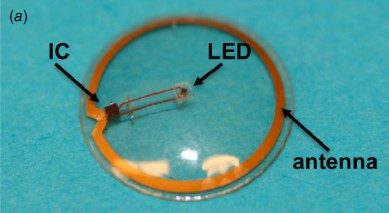 If you’ve ever
If you’ve ever done any thinking about augmented reality seen a sci-fi movie, you’re undoubtedly familiar with the idea of a contact lens that provides the wearer with a super-futuristic heads up display that shows all sorts of awesome and useful information, augmented reality style. Well, we aren’t quite there yet, but work being done is bringing that technology ever closer to that vision. Today such devices are being tested, in several years we may see them available for consumer purchase.
Researchers have recently manufactured and tested a simple 1 pixel contact lens display. Though one pixel doesn’t sound very impressive, it could be used for something as simple as notifying the wearer of an incoming call, text, or email, or could be as useful as alerting a deaf person that a car may be coming up behind them.
The resolution of such displays is bound to increase along with the functionality and usefulness of augmented reality devices like this, but this recent test was not so much about functionality as it was safety. You can imagine that it might be dangerous to operate something like a contact lens display that rests atop one of our most sensitive orifices; not only must the delicate electronics not irritate or damage the eye, but the display mustn’t generate too much heat (which could lead to either discomfort or even eye-health concerns).

For this reason, rabbits were used to test the display. Under anesthesia, the prototype contact lens display was placed into the eye of a rabbit, the single pixel was successfully lit, and the contact was removed, all without damaging the rabbit’s eye. Of course, longer term tests will need to be done to ensure that extended exposure to such displays doesn’t have any detrimental effects, but in the short term things are looking positive.
Arguably, the biggest challenge of a contact lens with a display on it is not cramming the pixels in, but rather powering the display. How does one power a display that’s so tiny that it doesn’t have room for a battery? Wireless electricity is the answer. Yes, I said it.
Because any part of the electromagnetic spectrum consists of waves that can be harnessed as energy, it is quite possible to capture that energy for use as electrical charge. Of course, we wouldn’t want to use waves that were harmful to us, like gamma or x-ray — so what’s a commonly used wave that’s invisible and harmless to humans? Radio waves of course!
According to the researchers, the prototype contact lens is powered by radio waves and consists of:
…an antenna, a 500 × 500 ?m^2 silicon power harvesting and radio integrated circuit, metal interconnects, insulation layers and a 750 × 750 ?m^2 transparent sapphire chip containing a custom-designed micro-light emitting diode with peak emission at 475 nm, all integrated onto a contact lens.
In addition to the single pixel prototype display, the researches also tested a lens which used a 3 x 5 grid of micro-Fresnel lenses sans the circuitry. This test was a proof of concept for some proposed designs which incorporate micro-Fresnel lenses which allow for a short-focal length (required if the display is to be in focus to the wearer) without the bulk that would be required from a traditional lens.

In the photo below, you can see a concept design which uses similar technology as the single pixel display that was tested, but incorporates 100 pixels which are all focused with micro-Fresnel lenses.

With more pixels, contact lens displays will be able to do much more than give us simple notifications. Augmented reality and wearable computer applications are easy to imagine. With complex displays, we could have a heads up display for our everyday life. Just imagine:
Wake up in the morning and see the time and weather instantly without looking at a clock or going online to check the weather. Check your emails/SMS/social networking notifications without even having to get out of bed or roll over and grab your smartphone. Hop in your dashless car and see all of the relevant info — speedometer, odometer, gas gauge, traffic conditions, etc. — without ever looking away from the road. Arrive at work and see when your first meeting is without having to sit down at your desk to look at your work calendar.
Integrate a few more systems, such as head tracking and optical recognition, and you can see even more amazing possibilities:
Use a hidden high resolution camera embedded in your clothes to scan the face of that friend who’s name you forgot at a party, have the system run a face-match on your known friends by checking your social networking contacts then display the name on your HUD without your friend ever knowing that you forgot their name. Or perhaps a surgeon will be able to zoom in and out dynamically on the innards of his patient while doing a complex surgery, all the while being able to monitor their vital signs on the HUD.
There are so many possibilities for this sort of technology, and thanks to some incredibly smart people working on developing them, we might even see their practical application in our lifetime. These are very exciting times.
Though the idea is futuristic, the concept has been around for quite some time. A brief search reveals a patent issued way back in 1997 that describes an invention that is extremely similar to that which was tested just this year. No doubt the idea was theorized about long before someone came up with a patent.
The contact lens display (aka bionic contacts) tests that I wrote about above were published in the Journal of Micromechanics and Microengineering, Volume 21, Issue 12. If you’re interested, there are lots of additional details in the full paper which you can find right here. All images, unless otherwise noted, were originally published in the paper.







Pingback: Augmented Reality Hasn’t Proven Itself… Yet. « Road to Virtual Reality()